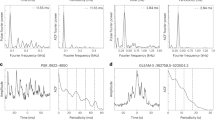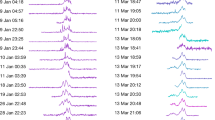Abstract
IN this communication an attempt is made to account for the salient features of the pulsed radio sources first discovered by Hewish et al.1, by means of a model based on a pair of neutron stars forming a binary system. Associated with each star of this system is a plasma which is a directional source of high frequency radio waves. The rotational motion of the stars about their common centre of gravity accounts for the observed constancy of the pulse repetition frequency, while the shape and time variation of the plasmas account for the shape, power spectrum, polarization and variability of the pulses.
This is a preview of subscription content, access via your institution
Access options
Subscribe to this journal
Receive 51 print issues and online access
$199.00 per year
only $3.90 per issue
Buy this article
- Purchase on Springer Link
- Instant access to full article PDF
Prices may be subject to local taxes which are calculated during checkout
Similar content being viewed by others
References
Hewish, A., Bell, S. J., Pilkington, J. D. H., Scott, P. F., and Collins, R. A., Nature, 217, 709 (1968).
McIlraith, A. H., Nature, 212, 1422 (1966).
Robinson, B. J., Cooper, B. F. C., Gardiner, F. F., Wielebinski, R., and Landecker, T. L., Nature, 218, 1143 (1968).
Moffett, A. T., and Ekers, R. D., Nature, 218, 227 (1968).
Davies, J. G., Horton, P. W., Lyne, A. G., Rickett, B. J., and Smith, F. G., Nature, 217, 910 (1968).
Lyne, A. G., and Rickett, B. J., Nature, 218, 326 (1968).
Scott, P. F., and Collins, R. A., Nature, 218, 230 (1968).
Scheuer, P. A. G., Nature, 218, 920 (1968).
Drake, F. D., Gunderman, E. J., Jauncey, D. L., Comella, J. M., Zeissig, G. A., and Craft, H. D., Science, 160, 503 (1968).
Lyne, A. G., and Smith, F. G., Nature, 218, 124 (1968).
Burbidge, E. M., and Burbidge, G., Stellar Evolution, Handbuch der Physik (edit. by Flugge, S.), 51, 134 (Springer, Berlin-Heidelberg, 1958).
Saslaw, W. C., Faulkner, J., and Strittmatter, P. A., Nature, 217, 1222 (1968).
Thorne, K. S., Phys. Rev. Lett., 21, 320 (1968).
Author information
Authors and Affiliations
Rights and permissions
About this article
Cite this article
MCILRAITH, A. Model for Pulsed Radio Sources. Nature 220, 461–463 (1968). https://doi.org/10.1038/220461a0
Received:
Revised:
Issue Date:
DOI: https://doi.org/10.1038/220461a0
Comments
By submitting a comment you agree to abide by our Terms and Community Guidelines. If you find something abusive or that does not comply with our terms or guidelines please flag it as inappropriate.



